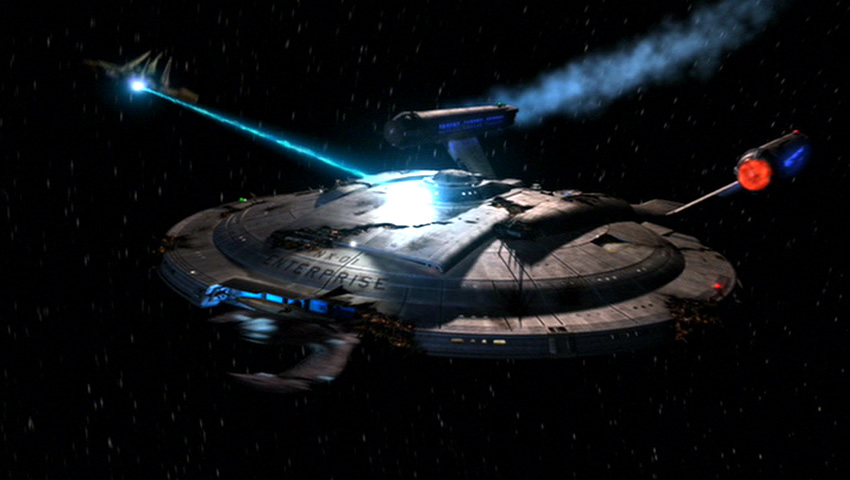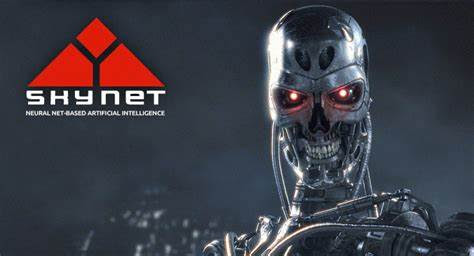Okay - science-fiction writers all know, especially when writing space operas about human-like aliens with similar technology to our own - like Star Trek, Star Wars, Stargate, Babylon 5... We all know we're actually writing fantasy much more than science fiction. Klingons are no more likely to exist than Orcs. Vulcans are no more likely than Elves.
That said, let's at least try to not egregiously violate the laws of physics... So how do you have space ship battles when traveling faster than the speed of light?

I'm going to stick to Star Trek, but this discussion could easily apply to other franchises or to your original space-opera story. And I'm going to make a ton of assumptions about Trek tech - based, you must understand, on a lifetime of viewing the various series, starting with watching reruns of the original series with my parents in the early 1970's. Family of nerds - it runs in my blood.
Okay - so when traveling at warp, the ship is at rest. It's not moving. It's stationary within its warp bubble. Space is the thing that is moving, which is how they get around relativity. There are all kinds of problems with this idea (starting with deceleration, which would destroy any solar system as soon as the ship arrives) but let's set that aside. Anything too problematic that makes the format impossible, we'll just take for granted there's a technobabble explanation that we don't really need to get into.
So phasers and disruptors are light energy. What happens when you fire them while traveling at, let's say, using the example in the screen capture above, warp 5? Well, Einstein actually thought about this (in the form of the light from a car's headlamps assuming the car is traveling close to the speed of light) so let's extrapolate. The phaser energy works normally within the warp bubble. But the moment it exits the warp bubble it enters relative space.
So if you fire your forward phaser cannon you would immediately pass through your own phaser's discharge. Sounds like a job for a failsafe feature. No shooting forward phasers while traveling at warp. But what about lateral phasers? Or rear guns? No safety issues there, but if you're shooting at another ship traveling at warp, you're into a skeet shooting problem. You have to calculate the light energy from your gun to shoot at where the enemy ship is GOING to be by the time your exceptionally slow phaser discharge gets there.
This means that the best place to be is in front of your enemy. Fire your rear facing phaser cannon and before they can even think - WHAM - they run right through the discharge. To realistically portray lateral combat, it would require curving lines of light energy (because our POV is within the warp bubble). Your enemy is next to you. You shoot at where they're going to be. That means you're shooting almost forward so that the energy, traveling outside the warp bubble, arrives at the enemy ship - well - actually - the enemy ship runs into that energy.
Okay - but what about photon torpedoes? I think the common error is to think that the "photon" in photon torpedoes has something to do with the payload. It makes more sense to me (again from watching the series) to assume that the "photon" (or in STV, "quantum") refers to the torpedo's propulsion system, allowing it to move at warp. Can it borrow warp energy from the ship firing it?
No. Once the torpedo exits the warp shell, it is no longer traveling at warp. Unless its propulsion system can get it to warp. Well, why not? We've seen small probes traveling at very high warp speeds (in STNG, think Ambassador K'Ehleyr.) So it makes more sense, when traveling at warp speed, to use a weapon that can also travel at warp speed.
But this now causes a problem for relative space combat (when NOT traveling at warp.) How do you defend your ship, in relative space, while fighting another ship, in relative space, from a weapon that moves at warp? (And there's the power of the torpedo - it doesn't need an explosive device. If it's traveling near light speed (not to mention faster than light) its mass alone is sufficient to deliver a whollup that would give a hydrogen bomb penis envy.)
Which now causes a problem for all out warfare. If someone wants to end all life on your planet, a few of those babies would definitely do the trick. Now you have to consider the danger of having enough of those extremely energetic weapons under the command of enough ship captains, all of them subject to the PTSD that universe-ending space-opera delivers every week. Doesn't even take a captain. A jilted quartermaster could probably figure out how to deliver civilization-ending payloads to their own planet over a love-affair gone horribly wrong.
And that's where planetary defense grids come in... Set to shoot down anything like a photon torpedo or a big fat old phaser beam before it gets anywhere near your homeworld. That's going to take a MAJOR investment in heavily armed satellites. Which creates a new problem... Who do you put in charge of THAT kind of firepower? SKYNET???

That said, let's at least try to not egregiously violate the laws of physics... So how do you have space ship battles when traveling faster than the speed of light?

I'm going to stick to Star Trek, but this discussion could easily apply to other franchises or to your original space-opera story. And I'm going to make a ton of assumptions about Trek tech - based, you must understand, on a lifetime of viewing the various series, starting with watching reruns of the original series with my parents in the early 1970's. Family of nerds - it runs in my blood.
Okay - so when traveling at warp, the ship is at rest. It's not moving. It's stationary within its warp bubble. Space is the thing that is moving, which is how they get around relativity. There are all kinds of problems with this idea (starting with deceleration, which would destroy any solar system as soon as the ship arrives) but let's set that aside. Anything too problematic that makes the format impossible, we'll just take for granted there's a technobabble explanation that we don't really need to get into.
So phasers and disruptors are light energy. What happens when you fire them while traveling at, let's say, using the example in the screen capture above, warp 5? Well, Einstein actually thought about this (in the form of the light from a car's headlamps assuming the car is traveling close to the speed of light) so let's extrapolate. The phaser energy works normally within the warp bubble. But the moment it exits the warp bubble it enters relative space.
So if you fire your forward phaser cannon you would immediately pass through your own phaser's discharge. Sounds like a job for a failsafe feature. No shooting forward phasers while traveling at warp. But what about lateral phasers? Or rear guns? No safety issues there, but if you're shooting at another ship traveling at warp, you're into a skeet shooting problem. You have to calculate the light energy from your gun to shoot at where the enemy ship is GOING to be by the time your exceptionally slow phaser discharge gets there.
This means that the best place to be is in front of your enemy. Fire your rear facing phaser cannon and before they can even think - WHAM - they run right through the discharge. To realistically portray lateral combat, it would require curving lines of light energy (because our POV is within the warp bubble). Your enemy is next to you. You shoot at where they're going to be. That means you're shooting almost forward so that the energy, traveling outside the warp bubble, arrives at the enemy ship - well - actually - the enemy ship runs into that energy.
Okay - but what about photon torpedoes? I think the common error is to think that the "photon" in photon torpedoes has something to do with the payload. It makes more sense to me (again from watching the series) to assume that the "photon" (or in STV, "quantum") refers to the torpedo's propulsion system, allowing it to move at warp. Can it borrow warp energy from the ship firing it?
No. Once the torpedo exits the warp shell, it is no longer traveling at warp. Unless its propulsion system can get it to warp. Well, why not? We've seen small probes traveling at very high warp speeds (in STNG, think Ambassador K'Ehleyr.) So it makes more sense, when traveling at warp speed, to use a weapon that can also travel at warp speed.
But this now causes a problem for relative space combat (when NOT traveling at warp.) How do you defend your ship, in relative space, while fighting another ship, in relative space, from a weapon that moves at warp? (And there's the power of the torpedo - it doesn't need an explosive device. If it's traveling near light speed (not to mention faster than light) its mass alone is sufficient to deliver a whollup that would give a hydrogen bomb penis envy.)
Which now causes a problem for all out warfare. If someone wants to end all life on your planet, a few of those babies would definitely do the trick. Now you have to consider the danger of having enough of those extremely energetic weapons under the command of enough ship captains, all of them subject to the PTSD that universe-ending space-opera delivers every week. Doesn't even take a captain. A jilted quartermaster could probably figure out how to deliver civilization-ending payloads to their own planet over a love-affair gone horribly wrong.
And that's where planetary defense grids come in... Set to shoot down anything like a photon torpedo or a big fat old phaser beam before it gets anywhere near your homeworld. That's going to take a MAJOR investment in heavily armed satellites. Which creates a new problem... Who do you put in charge of THAT kind of firepower? SKYNET???

